Connecting Children With Nature Through Smart Toy Design
Did you know that by the time a teen in the US reaches 16 years of age, they are spending less than seven hours a week in nature, and these trends are worldwide. Parents are as concerned about their children not having time outdoors as they are about bullying, obesity and education. But they are unsure about what to do.
Parents have increased concerns for their children’s safety. They are less willing to let their children play outdoors without direct supervision. As a result, children spend most of their free time in organized sports, music and arts activities. This results in less time for unstructured play than in previous generations. Richard Louv, writer and nature-time advocate, describes this condition as a “nature deficit disorder.”
Digital technology is often blamed for children not going outside. Yet studies have shown little difference in the outdoor time of children who follow the American Academy of Pediatrics media guidelines and those who do not.
When done right, digital technology can be part of the solution. It can help solve the unique challenge of motivating children to go from indoors to outdoors and then to connect with nature.
Smart Toys In The Market
A growing market of toys, known as smart toys, add “intelligence” to toys through electronics or digital devices. Smart toys aim to provide both companionship and educational experiences. Furby, a smart toy that arrived in the 1990s, focused on companionship and free play. More recent examples include:
- Smart Toy Bear by Fisher Price,
- Ubooly by Smart Toy LLC,
- Cognitoy Dino powered by IBM Watson and created by Cognitoys.
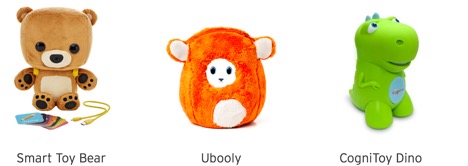
Bridging The Indoor, Outdoor And Nature Gap
In the US, hundreds of games and applications support children in outdoor play. Only a few of them focus on the unique challenge of transitioning children from the indoors to the outdoors and then connecting them with nature.
To address this gap, a company named Smart Toy LLC partnered with the National Wildlife Federation (NWF) to create a set of smartphone- and tablet-based activities branded with the NWF’s Ranger Rick character. The experience, referred to as Ranger Rick play packs, work with the Ubooly smart toy and mobile application. The activities encourage children to first get outside and then to engage with nature. For example, the Nature Ninja activity prompts children to act like ninjas, sneaking across their backyards to water plants with a spray bottle.
The NWF wanted to know to what extent Ubooly and the Ranger Rick play pack were successful in achieving their goals. We worked with them on a study to examine the user experience of the toys. Our goal was to identify design opportunities for smart toys for children in the future.
User Research For Play, Nature And Technology
We first dove into some desk research to understand the various issues at play related to the gaps between indoor, outdoor and nature play. From the literature and our discussions with key stakeholders at NWF, we identified four main areas of focus for our investigation:
- Motivations and use
What influences kids and parents to use smart toys to go outdoors and connect with nature? - Play context
What considerations do we need to make with smart toys in different play contexts? - Social roles
How do kids, parents and others interact when using technology outdoors and in nature? - Technology factors
What factors do we need to consider for smart toys in the outdoors?
To answer these questions, we designed a mixed-methods user research study. The study included pre- and post- surveys, a two-week diary study and a participatory design day with kids.
The pre- and post- survey enabled us to collect baseline data from across our participants’ answers to “what” and “how often” types of questions, such as: “What does your current access to nature look like?,” “What is your backyard like?” and “How often does your child initiate outdoor play?”
We chose the diary study method because it was the best method for collecting “in the wild” data about how kids might actually engage with a toy. It is a method that can transcend age groups, allowing both our child participants and caregiver participants to provide their insights along the way. It also enabled us to tackle the topic of motivation, helping us to see toy use over time, documenting how long the novelty of a new toy might impact its use — something that other methods, such as interviews and even direct observation, simply wouldn’t yield as much insight into.
Finally, we selected the participatory design approach specifically to help us think outside the box. The agile minds of children are particularly well suited to blue-sky thinking, and by designing with children, rather than for them, we adult designers are better able to address their latent needs and interests.
- Pre- and post-survey
Gather insights into baseline and Ubooly-driven outdoor, nature and technology interactions. - Diary study
Track use of Ubooly and Ranger Rick play packs over a two-week period. - Design day
Design with kids to explore concepts for smart toys that connect them to nature.
With the help of our client collaborators, we recruited 19 pairs of children and their caregivers. Of the 19 child-and-caregiver pairs, seven pairs were from Philadelphia, Pennsylvania, representing an urban setting. Twelve pairs were from Reston, Virginia, a suburban area. Participants in both areas had a variety of backyard types and varying access to nature. Our sample consisted of eight boys and eleven girls between the ages of 5 and 9, with predominantly female caregivers participating in the study.
We gave caregivers one week to fill out the pre-study survey, which consisted of closed- and open-ended questions. We used the pre-study survey to gather baseline information about the child-and-caregiver pairs:
- What are their indoor, outdoor and nature activities?
- What are their backyards like?
- How much access do they have to nature (i.e. verdant areas with natural foliage and/or wildlife, and green spaces such as nature parks, wilderness and wooded areas)?
- What role does technology play in their daily lives?
We used the diary study to get a glimpse of how children and caregivers interacted with Ubooly in their natural settings. We encouraged participants to play with it as they would other toys, during a two-week period. We asked caregivers to send written descriptions, images and audio-video documentation whenever children and/or they themselves played with Ubooly.
We provided all participants with a diary study packet containing a description and timeline of the study, as well as blank pages for submission of journal entries and pictures. This was an important aspect of the research because we’ve found that participants often need multiple pathways into a study and appreciate flexibility in how and when they can contribute. The variety of options for sharing feedback ensured that our study had rich and robust data from all participants and did not exclude anyone based on technological constraints.
We also sent three prompts to ensure we were collecting data connected to the key areas of focus. Providing open-ended feedback is often challenging for participants if they are given a completely blank canvas, so we scaffolded their data sharing with prompts that would ensure we addressed our main points of interest:
- Motivation and use prompt (4 days into study) “Please play with Ubooly and a Ranger Rick activity over the weekend and tell us a brief story about the experience you and/or your child had.”
- Play context prompt (6 days into study) “Ask your child to create a picture of their favorite place to play with Ubooly. Take a picture or scan the image and send it back to us via email.”
- Social roles prompt (8 days into study) “Interview your child and record it via video or audio. Take a few minutes to ask your child the following questions and record their responses. We welcome your own insight as well.
The social roles prompt included the following suggested questions for caregivers to ask their children:
- “Who do you like to share your Ubooly with?” Or, “Who do you like to play with most when you play with your Ubooly?” (for example, mom, dad, sibling, friend, no one).
- “Tell me a story about how you and [name of person mentioned above] played with your Ubooly. What was that like?”
- “Are there times when you don’t want to play with your Ubooly? Or when you don’t want to share it with others? Tell me a story about that.”
Although we sent specific prompts to ensure that our research questions would be answered, we did not provide guidance or requirements for how participants should play with Ubooly (i.e. indoors, in their backyard or elsewhere). We wanted to leave that open to participant interpretation to see what happened as a result of *Ubooly*’s prompting.
After the diary study, we sent out a post-study survey. Of the original 19 caregivers, 15 responded to the second and final survey. We asked caregivers to share whether and how any of their pre-study answers were affected by the two weeks in which they had access to Ubooly and the Ranger Rick play packs.
Finally, we hosted a design day at our office in Philadelphia with children in the target age group. We asked children to work with us to design “magic toys” that would help others like them connect with nature. These child designers created low-fidelity prototypes and drawings that helped us think about future opportunities for designing smart toys.
We did a qualitative analysis of the aggregate data. We looked for common themes that emerged from across the data from all three research methods. Aside from our four main areas of focus, we did not impose any structure or meaning onto the data, but rather allowed themes to reveal themselves. We used traditional qualitative analysis techniques for emergent coding, such as close reading and constant comparisons.
The technique of constant comparisons happens almost automatically for most qualitative researchers. It involves comparing each piece of data to another while looking for similarities and differences. As you read one piece of data, you compare and contrast it with the piece before it to refine your understanding of the overall problem and to clarify your themes. This allows for key findings to emerge as a result of frequency, as well as a result of those that stand out as comparatively different yet important.
As we reviewed the data set of text, images, drawings, videos and design artifacts, we compared each piece of data to the previous piece until no new themes emerged. The themes then became the foundation of our design guidelines for designing smart toys to connect children with nature, which we discuss in the next section.
Designing Smart Toys That Connect Children With Nature
Our analysis revealed 12 guidelines, or principles, for designing smart toys to bridge the indoor-to-outdoor gap and to connect kids with nature. We’ve provided them in the table below for quick reference. In the sections that follow, we go over key findings and examples from the data from which each of the design guidelines emerged.
Twelve Principles
| Area of focus | Design principle | Description |
|---|---|---|
| Motivations & use | Include physical activity. | Incorporate features and activities that support physical activity to motivate children to go outdoors. |
| Motivations & use | Tap into adventure & imagination. | Provide semi-structured, open-ended adventure scenarios to inspire children’s imagination. |
| Motivations & use | Activate the senses. | Activate kids’ senses and an appreciation for natural beauty. |
| Play context | Create connections to animals. | Take advantage of children’s natural interest in animals through personification and translation features. |
| Play context | Increase perceptions of safety. | Create perceptions of safety to help kids feel comfortable outdoors and in nature. |
| Social roles | Consider many caregiver roles. | Support many caregiver roles, both in outdoor and nature play and in technology. |
| Social roles | Connect to close-knit social group. | Connect kids to their close-knit social group through multi-participant or shareable experiences. |
| Technology factors | Protect technology outdoors. | Ensure that smart toys are protected from the elements and are safe from theft and loss. |
| Technology factors | Allow for hands-free play. | Support hands-free play through wearable features and add-on products (for example, carriers, satchels). |
| Technology factors | Extend the experience. | Use game-like points, levels and subscriptions to keep kids engaged once the novelty wears off. |
| Technology factors | Provide collect-and-store features | Incorporate features that allow kids to collect and store their experiences. |
| Technology factors | Leverage the mobile "senses." | Use all of the features and functions of a mobile device, such as camera, sound and geolocation. |
Motivations And Use
Through our line of inquiry related to motivations and use, we learned that when a user experience supports physical activity, provides adventure, fosters imagination and activates the senses, kids are motivated to connect with nature.

Access to nature is a challenge that cannot always be overcome. So, we were interested to learn that children’s imaginations were the best way to connect them with nature. We identified both semi-structured and unstructured adventure scenarios that helped children’s imaginations run wild.
Unstructured adventures supported learning through discovery, or curiosity-driven learning. It involves an exploration of nature without the imposition of rigid lesson plans. In our study, children and caregivers engaged in unstructured adventures and flights of imagination without the help of Ubooly. For example, one child wanted to go outdoors so that she could build a fairy house using leaves, sticks and flowers that she collected on her walk. Her caregiver noted, “She loves going on hikes and searching for items to add to fairy houses she has been building the last two years.”
Semi-structured adventures supported learning through scripted activities directed by Ubooly. For example, the Nature Ninja activity addressed several motivators for interacting with nature. It addressed children’s desires for physical activity, prompted them with an idea for an adventure and encouraged them to use their imagination. A parent recalled one of her and her child’s most memorable moments during the study:
“It was actively raining outside, but [my daughter] wanted to go out. So I armed her with the spray bottle, *Ubooly* (under a plastic bag) and a raincoat, and out she went into the yard. She kept crouching and sneaking around the yard. She loved the activity so much that she repeated it the following day without the rain.”
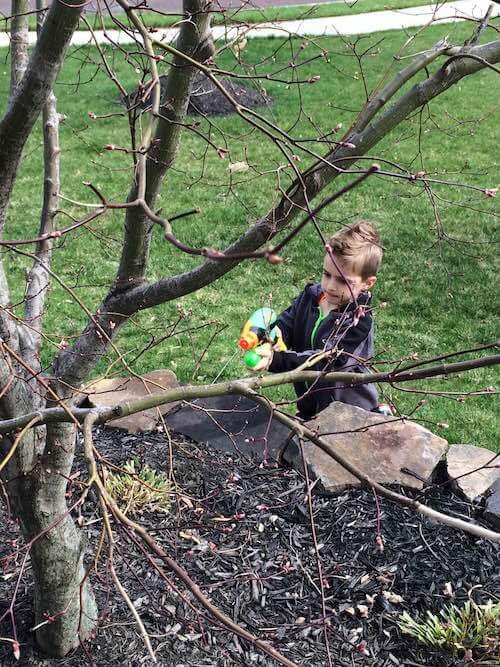
From the “Motivations and Use” category, we identified our first three design principles:
- Include physical activity
Incorporate features and activities that support physical activity to motivate children to go outdoors. - Tap into adventure and imagination
Provide open-ended adventure scenarios to inspire children’s imagination. - Activate the senses
Activate kids’ senses and an appreciation for natural beauty.
Play Context
Many of our caregivers reported visiting natural environments to connect with nature. They mentioned national parks, wooded trails, botanical gardens, lakes and oceans. But they also indicated that regular access to these nature-rich environments was difficult due to a lack of time and their distance from natural environments. Our study showed that children and caregivers actually spend most of their “nature time” in their own backyards or in nearby parks. The good news is that this did not stop them from finding ways to connect with nature.
We learned that using imagination in combination with any outdoor setting was enough context to support connecting. It was the missing link that helped children and caregivers achieve a connection with nature even if didn’t have direct access to it. Children imagined a world where they interacted with animals and nature from their own backyard, without fear of danger.
For example, one child drew a “bird feeder person” who would help her observe nature:
“[My daughter] designed a "person" who would serve as a bird feeder, bee and butterfly feeder, too. Nearby would be a place for us to sit and observe with binoculars and a journal and magnifying glass — maybe even a camera or a recorder to record the birds and insects. There would be a dish with water on her head for the birds that would look like a hat.”
A primary reason that children and caregivers connected with nature in their own backyards was because of safety concerns. Familiarity with one’s backyard makes it a more comfortable location for the whole family to experience nature, even if through the lens of the child’s imagination.
We saw this come up several times during our design day with children. Several children created apps that used animal sounds or colorful alerts to warn them of danger in their play area (such as a poisonous plant, a wild animal or bad weather).
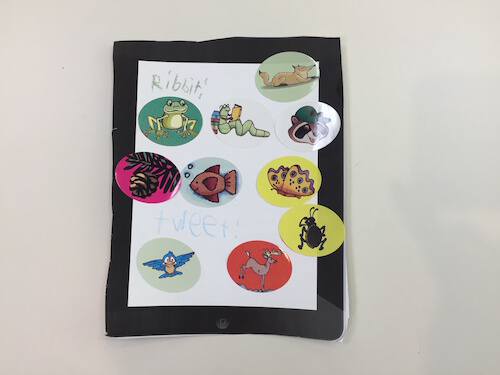
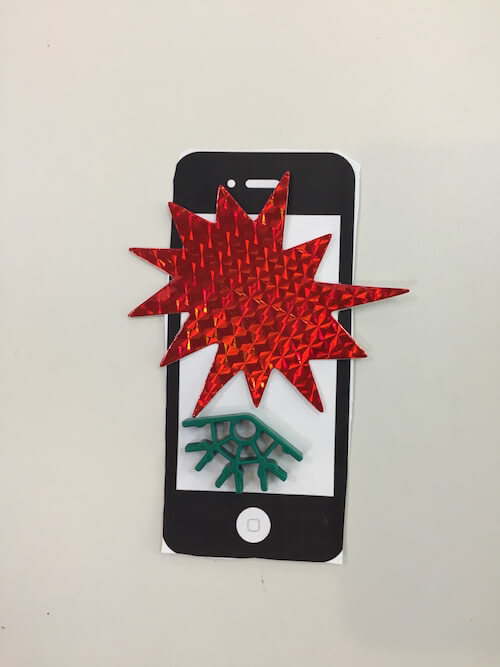
From the “Play Context” category, we identified two more design principles:
- Create connections to animals.
Take advantage of children’s natural interest in animals through personification and translation features. - Increase perception of safety.
Create perceptions of safety to help kids feel comfortable outdoors and in nature.
Social Roles
Our investigation into social roles highlighted a full range of interactions. Caregivers took on many roles when connecting with their children in the outdoors and in nature, and they took on similar (though often different) roles when connecting with their children and technology.
For outdoor and/or being in nature, caregivers took on the following roles:
- Facilitator
They helped their children gain access to new information or sites. - Companion
They actively participated in their child’s play. - Supervisor
They took a hands-off or more distanced role in their child’s play.
As an example of a facilitator role, one caregiver noted, “[My daughter] would often ask me what certain birds, tree leaves, flowers, bugs, etc. were, and I didn’t always know the answer. I would bring her inside and we would look on the Internet or through books to figure it out.”
The role parents played relative to technology also varied. Caregivers took on the following roles:
- Supporter
They helped their child download new apps. - Endorser
They encouraged the use of technology. - Monitor
They managed the amount of screen time and access to technology their child had.
As one caregiver in her monitor role suggested, “Nate was holding Ubooly, listening to him. It was a gorgeous day, but I was kind of worrying that he’s just having screen time outside!” The combination of these two sets of roles is what makes designing smart toys that bridge the indoor, outdoor and nature divide particularly interesting and challenging.
We also learned about the role of friends and siblings in playing with Ubooly. As one caregiver mentioned, “I initially thought of it as a single-person experience, but my kids were playing with it together. For example, one would hold the Ubooly while the other did the activity (e.g. watering plants).”
We saw that children wanted to engage in activities that supported collecting and sharing, but we observed that their group for sharing was a close-knit social group of friends and siblings (and/or parents and grandparents). They were less interested in sharing with strangers or through other broader social media approaches.
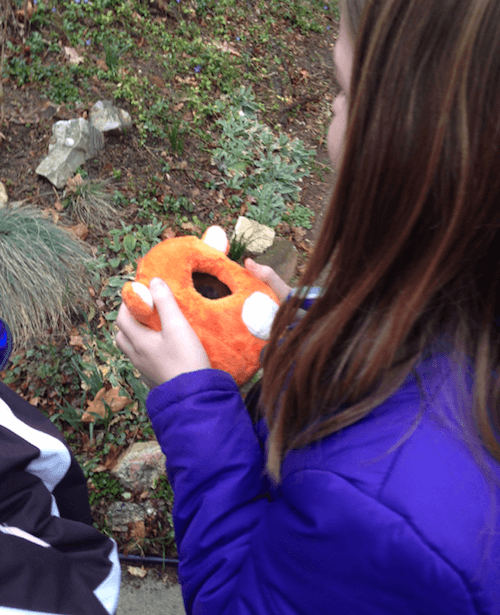
By looking at social roles, we identified two design principles:
- Consider many caregiver roles.
Support many caregiver roles, both with outdoor and nature play and with technology. - Connect to close-knit social group.
Connect kids to their close-knit social group through multi-participant or shareable experiences.
Technology Factors
Our final area of inquiry focused on the unique factors related to what happens when you put technology outside. From our cursory review of other smart toys, many of them are not intended for outdoor use. We suspected that a soft plushy toy like the one in our study might be a poor fit for inclement weather and dirt and might be affected by screen glare outdoors. This focus area uncovered the largest number of, perhaps obvious, design considerations.
Both children and caregivers want their toys to be safe outside — safe from the elements as well as from loss and theft. These concerns came up across both the urban and suburban groups.
Ubooly requires a caregiver to place their smartphone inside the stuffed toy. This created concerns for the safety of the technology itself. One caregiver summarized this by saying, “I would be hesitant to use Ubooly outdoors (since it is a plushy). In city playgrounds or parks, someone could easily snatch the plushy with my iPhone in it!” It also raised the issue that children need a way to carry the toy with them, both for safety and to allow for hands-free play.
Another challenge was the novelty of the toy wearing off. Even in our short two-week study, we saw drop off in use from one week to the next by some (though not all) child-and-caregiver pairs. Using game-like strategies to motivate children to continue to play with a toy is important. In order for a toy to successfully instigate behavioral change, children have to keep using it beyond their first few tries.
Finally, we identified opportunities for leveraging smartphone technology in a toy. The camera component of a mobile device is well suited to sharing experiences. Our child designers and participants were very interested in this. Particularly with smartphone-augmented toys, such as Ubooly, there’s an opportunity to leverage all of the sensors on a mobile device. Participants not only expected to be able to listen and respond to Ubooly, but also expected it to know their location (through GPS functionality).
In our design session, one child created a robot device that could see, hear, talk and translate animal sounds into human words. His drawing showed an animal telling him that he had “cool hair.”
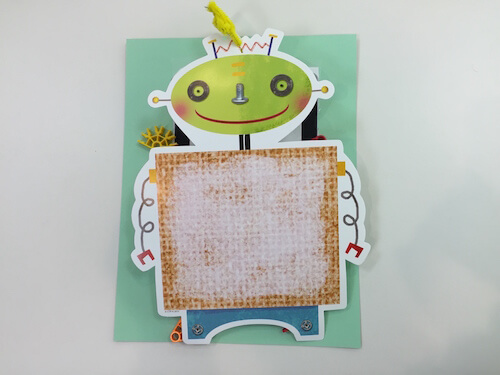

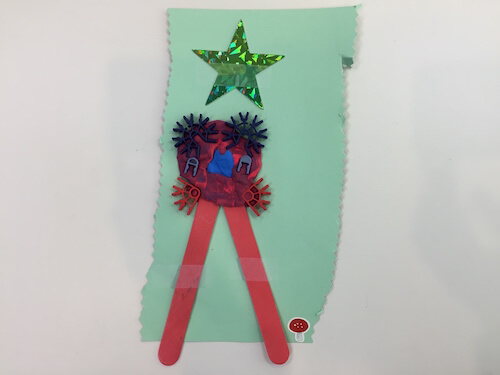
Looking at technology factors unique to indoor-to-outdoor play and to connecting with nature uncovered five more design principles:
- Protect technology outdoors.
Ensure the smart toy is protected from the elements and safe from theft and loss. - Allow for hands-free play.
Support hands-free play through wearable features and add-on products (for example, carriers, satchels). - Extend the experience.
Use game-like points, levels and subscriptions to keep kids engaged once the novelty wears off. - Provide collect-and-store features.
Incorporate features that allow kids to collect and store their experiences. - Leverage the mobile “senses.”
Use all of the features and functions of a mobile device, such as camera, sound and geolocation.
Designing Smart Toys For Your Context
Design is contextual. Although many of the design principles we uncovered apply across play contexts, some might not. What we learned from our east-coast US participants might not hold true in a snowy midwest Canadian context, for example.
If your context is different from ours, consider the motivations and barriers to use for your unique audience. You’ll gain insight into what gets people excited to pick up a toy and to move from indoor to outdoor play. Use a combination of rich qualitative methods, such as diary studies, to accomplish this.
Explore the opportunities of different types of play contexts to gain insight into how and where your users play. Combine baseline surveys of parents with drawings produced by children during their playtime.
Acknowledge the variety of social roles that influence smart toy use. Your end users might range from two children playing together to a child and caregiver. Consider the various roles that caregivers will take on when playing with your toy. Build unique prompts into your diary study, such as a parent interviewing a child, to understand how these roles play out during the course of your study.
Finally, account for the environmental conditions that affect the use of technology outdoors, and don’t be afraid to take full advantage of the technology’s features and functions! Use your good designerly sense here, as well as the reported concerns of your participants, to understand the full range of concerns that might arise.

Acknowledgements
We’d like to acknowledge our wonderful collaborators, Kelly Senser and Kevin Coyle. We would also like to thank our colleagues, Sal Nistico and Erin Chan, who contributed significantly to the design thinking for this project.
Further Reading
- Designing Web Interfaces For Kids
- A Dad’s Plea To Developers Of iPad Apps For Children
- Learning More About Creativity And Innovation From LEGO
- Massive Collection of Nature Inspired Typography



 Flexible CMS. Headless & API 1st
Flexible CMS. Headless & API 1st




